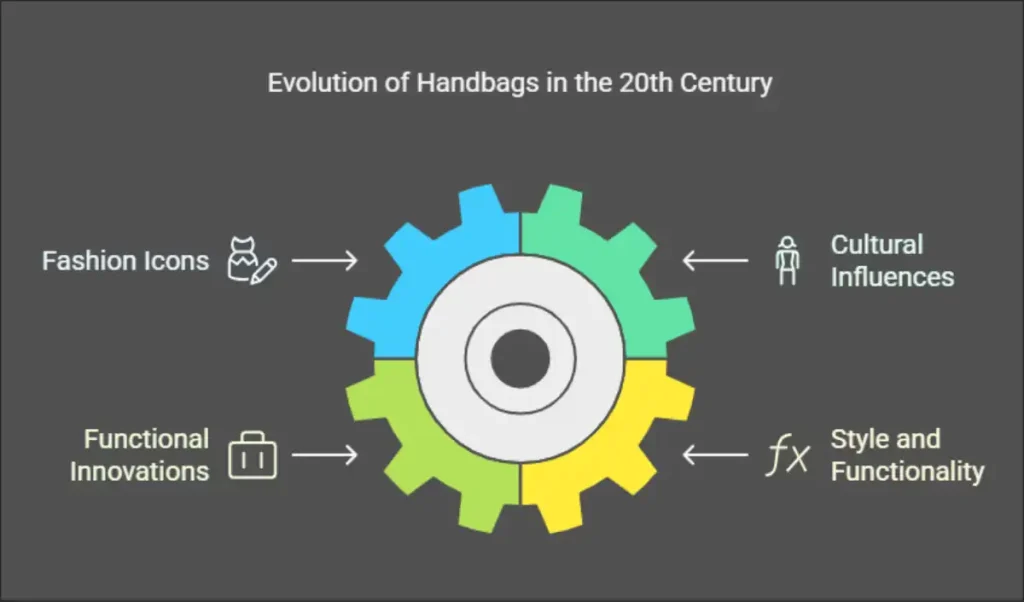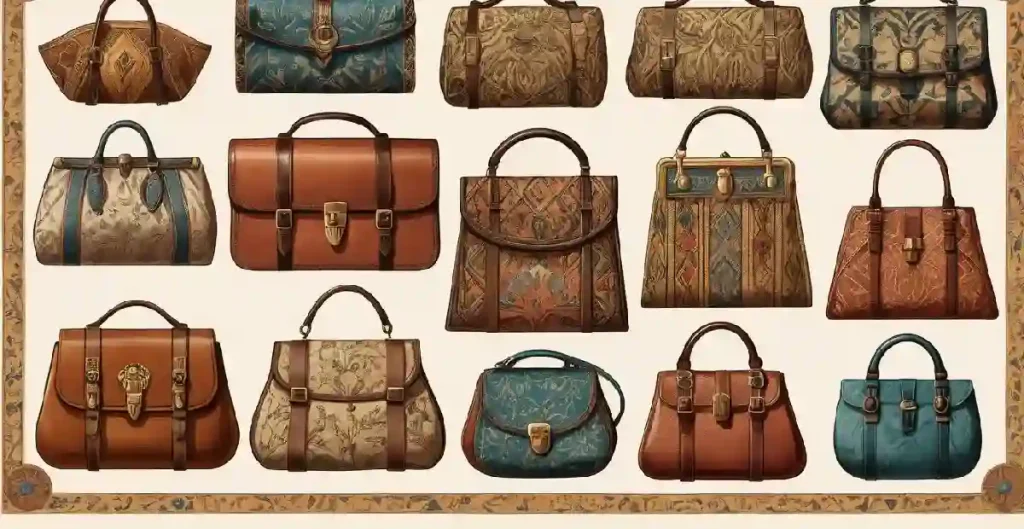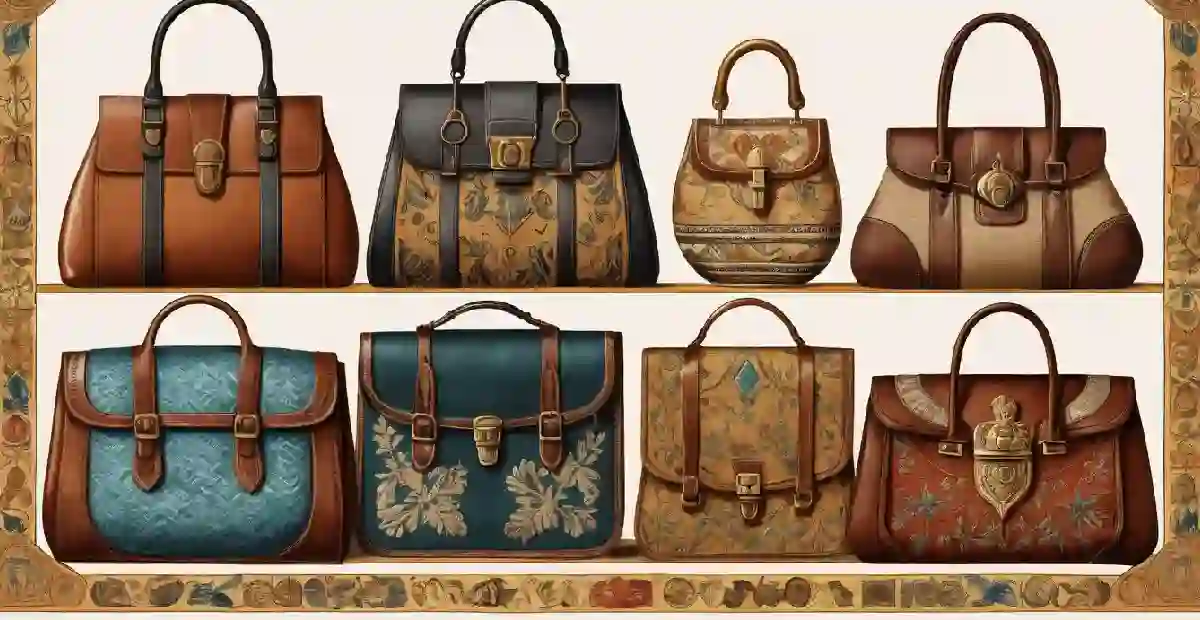From carrying everyday items to becoming a cultural artifact, bags are significant in our daily lives. The evolution of bags is an interesting history of human beings’ creativity and needs from the primitive pouch of the eras Then to the elegant designs of the present century.
Bags have evolved with the times, responding to the needs of the day. They were used to transport food, tools and personal effects themselves in the cultures of many ancient peoples around the globe. Over the years, as civilizations advanced, so did the bags, also changing in design, purpose, type of materials and more.
This article will take a brief look at the history of bags and what role they have played through different time periods in history. Through its pages, readers will learn about the history of bags, the trajectory of design and material, and how these accessories have influenced and been influenced by cultural practices. So, come with us as we unravel the history of bags and how they are a part of our life even today.
Table of Contents
ToggleAncient Origins of Bags
Prehistoric Beginnings
Bags have a rich history, stretching back to prehistoric times when early humans needed functional ways to carry things that were important to them. Considering that animal hides are readily available and tough, the first bags have probably been made of them. These early forms of pouches enabled our ancestors to carry tools, food, and anything else they needed while moving from one place to another in order to gather supplies. Even plant materials were used to make some simple bags that served a purpose as well.
Bags were an essential part of daily life in these civilizations. They served a purpose, but they also exhibited the talent and ingenuity of their artisans. When humans transitioned to more rooted lifestyles, the needs of the bags developed too, and bags started to become more complex in their designs for meeting multiple needs.
Bags in Ancient Civilizations
Bags as a product took on more structured shapes and functions over the years as the modern world transitioned into a more advanced civilization. Bags in ancient Egypt were made of linen and hand made, with unique designs. They were multi-purpose in society, used for transporting goods and even holding personal items. Apart from their functional uses, bags similarly had a powerful value in the culture. They were often part of burial ceremonies, representing the trip to the afterlife for example.
Bags were also used in everyday life in Mesopotamia and the Indus Valley. Bags played an essential role in the economy of Mesopotamia, as they were used by merchants to carry goods to and from the market. Across the world, in the Indus Valley, archaeologists have found evidence of bags for carrying food and tools — further proof that when it comes to practicality and functionality, bags have always served their purpose.
Symbolism in Early Bags
In addition to their practical uses, bags also held symbolic significance in ancient cultures. Many times they were involved with religious rituals, making a person with the vessel to the gods or the sacred items. In these settings, bags went beyond their literal function, serving as symbols of belief and cultural heritage.
Bags have history—of their function and meaning, and how even bags have changed over the centuries with the evolution of mankind and their relationships with their belongings. Traversing back in time, it should be noted that bags have been much more than mere functional items, but rather, an integral part of our cultures and societies.
Medieval to Renaissance Period

Bags in Medieval Times
Bags have a certain kind of historical flavor that emerges over a period of time, but within the medieval period we see that balance between pragmatism and art. In Medieval Europe, bags were needed as accessories for general use as well as for more specific functions. The most predominant variants included girdle bags and pouches. Girdle bags were ornamental bags hanging from a belt or girdle, which men and women alike often used to carry coins (or small tools or personal items). Pouches, in contrast to another, were also different in size and form, meeting needs for the carrier herbs and valuables.
During this period, the bag was intricately tied to the stringent gender roles of the time. Bags for men were at times, practical with focus on utility, and for women, highly ornamental with a lot of embroidery and ornate work. The difference in the design of bags was also a reflection of the larger state of society, considering that women’s fashion has always been biased towards the ‘looks’ of a product rather than its practical implications. This split highlighted how bags were not simply the means of transporting goods but symbols of personal status and societal gender norms in the medieval world.
Renaissance Innovations
Moving closer to the Renaissance Era, the history of bags had many impressive advancements in either style or material. They were inspired by the era of renaissance, in which art and culture were being revived and inspired all forms of creativity and personal expression, even in the way of designing accessories. The designs of the bag became increasingly elaborate, often made with silks, velvets, reticules, beaded silk, and other lavishly patterned fabrics decorated with tassels and embroidery.
During the Renaissance we began to see the effects of wealth and class status on the style of your bag. The nobility and rich merchants with wealth excess would carry luxurious bags, frequently decorated with expensive metals and gems. On the other hand, the lower class relied on simpler bags with less expensive materials, representing their economic standing. The two stylings at this time signified a clear reach into the delineating nature in which classes were recognized, evolving the influence of fashion as a device to symbolize identity and social grouping.
Medieval and Renaissance bags were made and used in many different ways. The bag evolved from a mere object for carrying things to an element of quietly luxuriating in dignity, and then it became an integral part of daily life, a cultural driver: the bag was a tool and an art object, the talisman both of where we are and where we have been. Bags have existed for as long as civilization, and, as this evolution of functionality, materialization, and representation highlights, they are both practical objects and societal reflections and catalysts throughout time.
The Industrial Revolution’s Impact
Mass Production and Design
The Industrial Revolution, which lasted from the late 18th to 19th century, became a crucial juncture in the evolution of bags. Industrialization changed our manufacturing methods so that it became less expensive and mass produced. The production of bags became easier with the coming of machines and there could be different varieties of bags designed and manufactured. As a result, standardized styles like satchels and travel bags came on the market and found favor with the increasing middle-class gentility.
Those bags were mass produced and went from being handcrafted items to another item on the commodity shelf, attuned to a wider market. This democratization of bag styles allowed individuals from all walks of life to own a bag that met their needs for work, travel or leisure. But the designs evolved to an increasingly functional one, serving the needs of a society that was transforming and requiring more mobility and convenience.
Fashion Evolution in Bags
Another notable change that occurred in the 19th century is the context in which bags, mainly handbags came. Bags were started as items which are used for carrying things, but after that the influence of fashion designers kept changing the style and functions of bags so bags slowly became not just an useful item, but a very important fashion accessory. It was during this epoch when leading designers regularly unveiled exciting new textiles, elaborate decorations and out-of-the-box styles that piqued the public’s interest.
Handbags progressed to fashionable items for women and status symbols with real meaning. As women started viewing bags, as an extension to their outfits, the innovation and creative journey of bag designing experienced a galore. Decorative bags Beads and embroidery Practical bags And closures However, handbags quickly turned from utility accessories into inalienable parts of personal identity and pieces of fashion.
Final Thoughts on the Industrial Revolution and the History of Bags With the majority of bags being mass produced, they quickly transferred into major fashion items that paralleled the changing needs and status of women in society. This era paved the way for the ongoing development of bags, both functional and fashionable, in the decades that followed.
20th Century Trends

Rise of Handbags as Fashion Icons
The 20th century ushered in an important new chapter in the book of bag history, as handbags came to be seen as trendsetters in their own right. And as cultural forces transformed society with things like the women’s liberation movement and the looser norms that came after, bags became not just necessities but identities, basically, symbols of style in their own right. During this period iconic designers such as Coco Chanel and Gucci helped shape handbag trends. The birth of classic Chanel 2.55 is a game-changer for the handbag market, offering the practicality of a crossbody while maintaing a level of elegance that Chanel brought to her pieces back in 1955 With its classic monogram, Gucci made luxury handbags that were the sign of status and elegance.
These top fashion designers influenced more than just aesthetics — they defined how fashion related to functionality. While handbags were prominent on runways, cultural movements around the same time such as feminism and an increase in the number of women in the workforce called for bags that showed off one’s personal style while also being functional. The change was responsible for a plethora of styles that addressed different facets of modern life, enabling women to embrace individuality and personal style.
Functional Innovations
Later on in the century, more and more emphasis was put on functional innovations that would continue to shape the design of bags. As life got more complicated, one bag became more specialized. Diaper bags, for example, were made with the parent in mind, with room for bottles, diapers, and other baby must-haves. Likewise, gym bags came along to make it a tad easier for fitness lovers, offering a handsome bag with stylish functionality to move workout paraphernalia around.
These fine bags showcased a step up in the history of bags; they adapted according to the different lifestyles and choices of the people. This insistence on function was not made at the exclusion of style but instead, allowed designers to create bags that incorporated both seamlessly. This trend continued to define the handbags market which resulted into the introduction of multiple type product offering as per the requirement of consumer segmentations.
From the handbag as a fashion statement to the functional variety of bags that are necessary for modern day life the 20th century was an exciting time for bags. This mixture of function and form created a preview for trends to come, leaving bags set to be an ongoing part of the lives of people all over the world.
Contemporary Bag Trends
Modern Bag Types
That particular look of bag history is one of the timeline that we live in now, based on the needs and styles of a bag. Three of the hottest bag categories today are tote bags, crossbody bags, and backpacks, all designed for a higher purpose.
Tote bags may be a daily companion that has a large pocket and a handle. Great for groceries and the office, tote bags are usually made from heavy-duty materials, like canvas or nylon, and are simple to wash and maintain.
Crossbody bags have gained Instagram popularity for their hands-free functionality and convenience. Perfect for city-slickers and wanderers alike, they allow access to the essentials with comfort and security, making them a staple for the on-the-go person.
Even backpacks have made a comeback, but these come with designs that combine trends and use. Fashionable in designs from sporty and minimalist to bold prints, modern backpacks fit a student carrying books and electronics, a business professional carrying a laptop, or someone hiking with gear.
Today, we design bags and backpacks that fit the functions needed of modern bags as opposed to the periods for which they were designed, focusing on pace and ease of use over craftsmanship.
Sustainable Practices in Bag Production
Bag makers have also adopted more sustainable methods of production as people become more aware of their impact on the environment. Consumers are looking for more responsible choices, which has made eco-friendly materials and designs more popular than ever. To reduce the environmental footprint of bags, brands are looking at new alternatives, from organic cotton to recycled plastics to even biodegradable materials.
A big trend is the reusable tote bag which signifies sustainability with an eco-friendly mindset. Consumers have started choosing reusable bags instead of single-use plastic – a small step in embracing a way of living with less waste. The bags have a great importance in daily life as well, and retailers and organizations almost always promote the use of these bags by providing incentives.
Today Bags Trends highlight a combination of utility and maintenance which resonate new needs and ethics of the society. Throughout the years, bags have always developed and still become one of the most important parts of a human being’s life, where bags are not only function-oriented but also an environmentally conscientious product as well.
Global Perspectives on Bags

Cultural Variations in Bag Design
Bags have a rich history, and its designs present cultural identities from the different regions of the world. All these cultures have invited different styles as primary elements of craftsmanship and artistry.
Asian silk bags are known for their bright colors and detailed patterns, typically made from rich silk and embellished with ornate embroidery. They can be small evening clutches or big totes and are often embroidered with symbols and patterns representing wealth, longevity or good fortune. For example, in places such as China or even Japan silk bags are seen not only as functional devices, but something with a cultural connection, which may even be presented as a gift on important holidays.
Beadwork bags from Africa — They celebrate this region of the world’s artistic tradition. Beaded bags are made from a variety of colored beads and woven materials, and are often considered status symbols, indicating the wearer’s community, age, or marital status. The elaborate motifs and hues feature various stories to tell for every design representing a symbolism that weaves a narrative of a rich cultural tradition ever so finely knitted into the culture of daily life.
These may be unusual styles of bags, but they show that bags are not merely just accessories to our wardrobe; they are part of our identity and expression of ourselves as a culture. They are vessels for stories, for tradition and the thread between generations.
Luxury Markets and Trends
The luxury bag industry is a multi-billion dollar segment in the world of fashion, known for its exclusivity and prestige. The global market for handbags is led by large brands, including Louis Vuitton, Hermès and Chanel, whose bags are often symbols of status.
Perspectives on luxury tote bags vary from culture to culture. Owning a luxury bag may, in some areas, indicate monetary value and social status, while in others, creative expertise and artistry. Many people wear luxury bags for fashion, especially in the Western culture, while in Eastern culture, people wear luxury bags quite for heritage and tradition.
Additionally, there is a tendency for inclusiveness and sustainability in the luxury bag market. With these new consumers are on the lookout for brands that focus on ethical production and transparency — luxury brands are adjusting their strategies to create collections with eco-friendly textiles and responsible sourcing. The evolution marks an increasing recognition of the social and environmental burden of luxury purchasing, influencing trends in an increasingly global market.
Conclusion: The cultural diversity and global luxury trends reflected in bags show how multifaceted bags are in their role in society. We love individual, personal expressions of heritage and ideals, as these things (probably more than any other category of fashion) can be both the most microcosmic and the most macrocosmic reflections of identity, status, and what it means to be a member of specific cultural spheres, from the ways people and brands celebrate heritage through individual designs to the ways they come to terms with the fact that their markets are where the luxury narrative is evolving so fast (exceeding all expectations, apparently) that the critical comment section is now about as soft as the comments section underneath your average Rosalie video.
The Future of Bags
Technological Innovations
And the future of technology will completely change the history of hand bags. Here we are dealing with intelligent luggage bags Feature known as smart bags, a new era of designing and functionality. Many of these bags offer built-in charging options, giving users the ability to charge their devices on the way. In a world where everyone is so attached to their smartphones, tablets, or even laptops, the need for a bag that has the ability to offer power on the go is most definitely a requirement for busy professionals, public transport users and travelers alike.
Smart bags might also have RFID (Radio Frequency Identification), an anti-theft function that enables users to track their bags. Not only do they look good, but with RFID blocking pockets, they are also great for keeping your credit cards and passport details safe in an ever increasing digital world.
Emerging Consumer Trends
The future of bag design is also being impacted by emerging consumer trends. I noticed one that was an apparent move towards minimalism which is upon us with consumers wanting more simplistic functional accessories. With straightforward silhouettes, neutral designs, and adaptable colors, minimalist bags can go with multiple outfits as well as events. It points to an increasingly perceived need for functional goods, stripped of all excess.
A global trend towards minimalism is complemented by a growing desire for multifunctional design. Contemporary consumers want their bags to serve myriad functions — a backpack that transforms into a tote or a handbag with straps that slip off. These feature-rich designs aimed at the convenience and pace of life as we know it today, allow its users the freedom to interchange the bags per the situation of use, seamlessly!
Additionally, the move towards sustainable and ethical production processes is expected to intensify. Consumers are becoming more eco-conscious and demanding transparency of brands. Such a trend is expected to encourage innovation in sustainable production process methods and also the utilization of sustainable materials. Brands that focus on ethical practice – through recycling, waste reduction and fair labor conditions – should appeal to consumers parched for the power to make responsible purchases choices.
The future of bags will see a lot of tech and consumer demand evolution. With intelligent features endowing them with new capabilities and minimalism as well as sustainability driving design, bags will evolve to serve the needs of contemporary lifestyles. As such an evolution will make bags inevitable accessories that not only express personal tastes but also message a commitment to innovation and social responsibility.
Conclusion
The history of bags is an exciting process from ancient times to the present day in terms of the evolution of design, function, and cultural significance. Bags have been simplistic pouches from prehistoric civilizations to high-tech working smart bags and have been used for hundreds of purposes from carrying daily necessities, and displaying personal aesthetics, to cultural backgrounds.
Bags are not only functional objects but also part of our fashion and social history. They have evolved to satisfy the shifting requirements of their constituents, helping shape and mirror mass culture and elevated style. Bags are part of our lives just like accessories, they add richness to outfits, signify high status, and help us reflect our lifestyle.
Future Trends Suggestions The ongoing evolution of bag design will continue to be exciting, a combination of new technology, changing consumer interest, and perhaps more interest in sustainability. Bags, however, will always be constant and will continue to evolve with society, as durable friends that will always manage to maintain functionality, style, and moral responsibility. Through this journey we can not only recognize the essential role bags play within our day to day but their legacy continues to evolve within culture and fashion as we journey into the future.
Frequent Questions (FAQs) Related to the History of Bags:
How did bags evolve from ancient times to the modern era?
From the old to the contemporary world, bags have come a long way:
Bag through time: Early bags were crafted from hide and plant fibers, carried food and primitive technology, and held cultural meaning.
From Medieval to Renaissance: Girdle bags and pouches: fashionable and status-bearing craftsmanship
IMPACT OF THE INDUSTRIAL REVOLUTION: The era gave rise to mass production techniques as well as standardized styles such as satchels, making bags more commonplace.
The 20th Century: Handbags become fashion statements, influencing trends of designers like Chanel to come to life, also outlets for specialized bags for specific needs.
Modern-Day: Present-day bags are still functional, naming several types bags that expand from its original intent, such as smart bags and even sustainable ones which have gained remarkable followership regarding its kind.
A perfect representation on how bags evolved with time according to the changing lives yet being an irreplaceable part of our everyday life.
What types of bags were popular during the medieval period?
Many kinds of bags were fashionable during medieval times; all performed different functions and all were indicative of social class. Notable examples include the following:
Girdle Bags Small bags worn on the belt or girdle to hold personal items, money and little tools used by both sexes.
Pouches: Pouches were primarily made of leather or cloth and they were available in a variety of shapes and sizes and were used to carry important items — whether food or valuables — in Ancient times.
Satchels: Bigger than pouches, satchels were to carry books, documents or trade goods. They were mostly worn on the shoulder.
Cloak Bags: They were specifically designed to remain hidden beneath cloaks and were used to carry coins or valuables or money.
Market Bags: These bags were favored by both traders and commoners alike, since they were convenient to use for carrying both goods and provisions during shopping or trade.
Such bags had practical functions, yes, but they were also displays of status and skill, two things that were highly valued among medieval folk and something that made these bags almost more than just accessories.
What materials were historically used in bag making?
A full overview of the history of bags would reveal the myriad of materials used in their manufacture, the modern incarnation of which we will explore here, each new technology in the available materials being reflected in the styles of bags created in them. Here are some key materials:
Leather from animals like cows, goats and sheep for its strength and resilience.
Natural Fibers: In ancient and medieval times, plant based materials; cotton, hemp, jute and linen were used to weave and stitch bags from natural fibers.
Pouches and Bags: Felted wool pouches and bags were used for their insulating and seamless properties.
Silk: Silk was also used for more luxurious bags in ancient times (eg. China), usually with elaborate patterns.
Canvas — Canvas is an older material that gained popularity as the Industrial Revolution progressed, as it was sturdy and versatile enough to be used for many of our everyday bags.
Synthetic Materials: Nylon and polyester became popular materials in the 20th century, providing lightweight, waterproof options for contemporary bags.
Historically, these materials determined both the functionality of bags and their aesthetic appeal.
How has the perception of bags changed over the decades?
The perception of bags has evolved significantly over the decades, reflecting changes in fashion, culture, and societal values:
1. Early 20th Century: Bags were primarily functional, used for carrying essentials. Their designs were often practical and simple.
2. 1920s-1930s: The rise of fashion icons and designers like Coco Chanel began to elevate bags as status symbols, combining function with style.
3. 1950s-1960s: Handbags became more fashionable and personalized, with unique designs that reflected the wearer’s style. Luxury brands gained prominence, and bags became essential accessories.
4. 1970s-1980s: The introduction of bold colors and eclectic styles reflected the counterculture movements. Bags began to be seen as expressions of individuality.
5. 1990s-2000s: Designer bags became highly coveted luxury items, with brands like Louis Vuitton and Gucci leading the market. The “it bag” phenomenon emerged, with bags often seen as investment pieces.
6. 2010s-Present: There is a growing emphasis on sustainability, functionality, and versatility. Reusable tote bags and eco-friendly materials have gained popularity, reflecting a shift towards environmental consciousness.
Today, bags are perceived not just as functional items but also as fashion statements, cultural symbols, and reflections of personal identity.
What part do bags contribute to sustainability today?
Today bags play a BIG part in sustainability in many ways:
Chasing the change through reusable bags: The increased use of reusable shopping bags has led to a substantial reduction in the use of plastic bags, ultimately helping to reduce plastic pollution and promote sustainable practices.
Sustainable Materials: Numerous brands are shifting to environmentally-friendly materials, including organic cotton, hemp, recycled plastics, and compostable fabrics, to manufacture bags with a reduced carbon footprint.
Demand for bags made with fair labor practices and ethical standards. Today, consumers are increasingly aware of the social and environmental consequences associated with their purchases.
Sweeping trend: current modern designs for bags focus on minimalism and multi-function use, with the aim of purchasing less bags, usually of high quality that can be used for various purposes, thereby contributing to less waste
Awareness Campaigns: Businesses and groups raising awareness of the environmental impacts of producing and disposing of bags, and encouraging consumers to make greener choices.
All in all, bags have turned out to be an important part of the sustainability trend, which is an ongoing trend today, more and more focusing on how consumers would go about purchasing and taking care of protecting the surrounding environment.
What are some emerging trends in bag design for the future?
The future of bag design will embrace functionality, sustainability, and technology as emerging bag design trends. Here are some key trends:
Smart bags: It is becoming more and more common to integrate technology (charging or GPS tracking). Many smart bags have charging capability and can help a user locate a misplaced item.
Eco Materials: Increasingly, designers have also introduced eco-friendly materials, such as recycled plastics, organic cotton, and natural resource- based and innovative textiles for crafting eco-friendly bags.
Minimalism : The minimalist trend favors simplicity and crisp lines which inspires consumers to select bags that can be used for not only multiple purposes but also can be more than one type of bag.
Customized Color and Design: The trend of personalization is on the rise with brands providing customizable elements that let consumers pick colors, patterns, and accessories to make their products stand out.
Versatile Styles: Bags that change from one use to another, like a bag that turns from a backpack to a tote are also trending, appealing to both busy lifestyles.
Support for Local Artisans: People are recognizing the importance of supporting local artisans and traditional craftsmanship, so there is a rise in bags made locally emphasizing the merit of handcrafted products.
They are into innovation, sustainability and personalization and how they will continue to influence bag design moving forward into the future.





